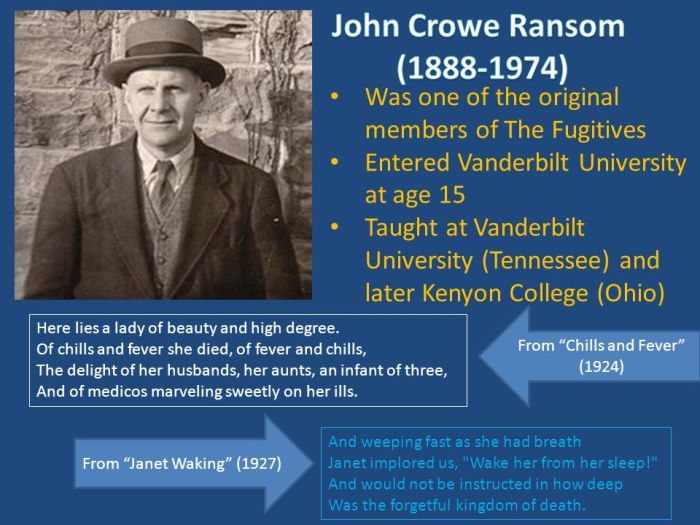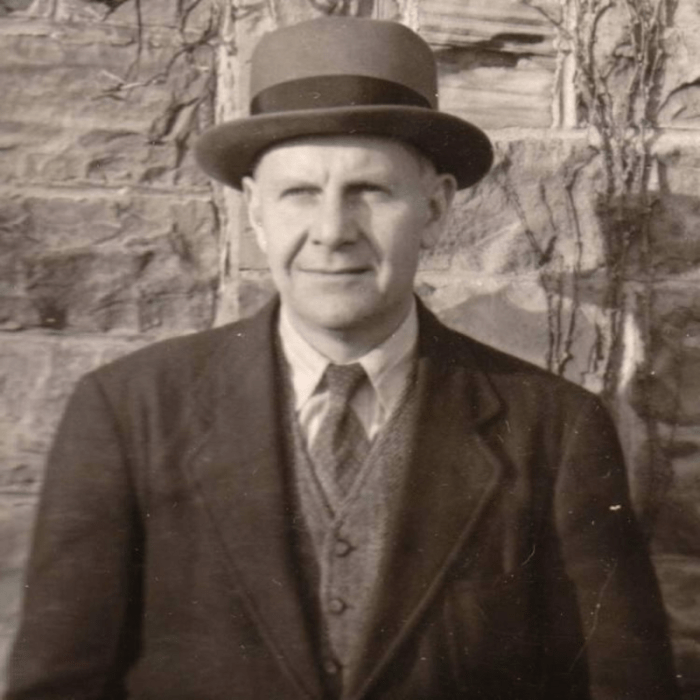Janet waking by john crowe ransom – In John Crowe Ransom’s evocative poem, “Janet Waking,” readers embark on a captivating journey of awakening and self-discovery. Through vivid imagery and intricate symbolism, Ransom explores the transformative power of consciousness and the complexities of human nature.
The poem unfolds as Janet, the protagonist, stirs from sleep and grapples with the transition from the ethereal realm of dreams to the tangible reality of the waking world. Ransom’s skillful use of language and poetic devices paints a vivid tapestry of Janet’s inner turmoil, capturing the disorientation, wonder, and trepidation that accompany the act of waking.
Introduction

John Crowe Ransom’s “Janet Waking” is a poem that explores the themes of innocence, awakening, and the transition from childhood to adulthood. The poem is set in a rural landscape and follows the protagonist, Janet, as she awakens from a dream.
Analysis of Imagery

Ransom uses vivid sensory imagery to create a rich and evocative atmosphere in the poem. The poem is filled with images of nature, such as “the yellowhammer’s song” and “the dew-drop on the grass.” These images help to create a sense of peace and tranquility, which is in contrast to the more chaotic and confusing world that Janet is about to enter.
Symbolism and Metaphor
Ransom also uses symbolism and metaphor to enhance the poem’s thematic depth. The “yellowhammer’s song” can be seen as a symbol of innocence and childhood, while the “dew-drop on the grass” can be seen as a symbol of purity and new beginnings.
The poem’s central metaphor is the comparison of Janet to a “flower.” This metaphor suggests that Janet is on the cusp of a new phase in her life, and that she is about to blossom into a beautiful and mature woman.
Poetic Structure and Form, Janet waking by john crowe ransom
The poem is written in a free verse form, which gives it a sense of spontaneity and immediacy. The poem’s lines are short and simple, which helps to create a sense of rhythm and flow. The poem’s rhyme scheme is also irregular, which further contributes to its sense of freedom and movement.
Themes and Interpretations
The poem’s major themes include innocence, awakening, and the transition from childhood to adulthood. The poem can be interpreted as a celebration of the beauty and innocence of childhood, as well as a warning about the challenges and complexities of adulthood.
The poem can also be interpreted as a metaphor for the creative process, as it suggests that art can help us to see the world in a new and more innocent way.
Literary Devices and Techniques
Ransom uses a variety of literary devices and techniques in the poem, including alliteration, assonance, and enjambment. These devices help to create a sense of musicality and impact in the poem. The poem’s use of alliteration is particularly effective, as it helps to create a sense of rhythm and flow.
The poem’s use of enjambment also helps to create a sense of suspense and anticipation, as it forces the reader to pause at the end of each line.
Historical and Cultural Context
The poem was written in 1924, during a time of great social and cultural change. The poem’s themes of innocence and awakening can be seen as a reflection of the changing values of the time. The poem can also be seen as a response to the growing urbanization and industrialization of the United States.
The poem’s rural setting and its focus on nature can be seen as a longing for a simpler and more innocent time.
Commonly Asked Questions: Janet Waking By John Crowe Ransom
What is the central theme of “Janet Waking”?
The central theme revolves around the transformative power of consciousness, the exploration of identity, and the interplay between the inner and outer worlds.
How does Ransom use imagery to create a vivid atmosphere in the poem?
Ransom employs sensory imagery, such as tactile sensations, visual descriptions, and auditory elements, to evoke a vivid and immersive atmosphere that captures the disorientation and wonder of awakening.
What is the significance of the symbolism in “Janet Waking”?
The poem is rich in symbolism, with objects and actions representing abstract concepts. For example, the “white” of the morning light symbolizes purity and new beginnings, while the “black” of the night represents the subconscious and the unknown.
